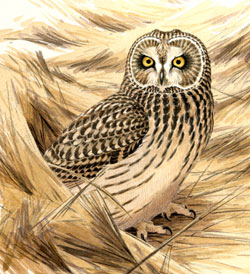Find a Bird - BBA1
Breeding Bird Atlas 1 Species Accounts
Short-eared Owl
Asio flammeus
State Status
Endangered
Egg Dates
March 15 to July 18
Number of Broods
one

A bird of open country, the Short-eared Owl requires habitats of grasslands, fields, marshes, and bogs. After much of the land had been cleared for agriculture, this owl was found as an uncommon summer resident throughout the state. More recently, development and changing land use patterns have had a severe impact. The species has declined in numbers, and it is now restricted as a breeder to the islands of southeastern Massachusetts. The nesting population in 1984 was estimated at 15 to 20 pairs, and in 1985 this owl was listed as an endangered species in the state.
Some Short-eared Owls are permanent residents, and others apparently move farther south for the winter. They begin establishing their breeding territories in Massachusetts from mid-March to early April. During courtship, male owls vocalize and sky dance to attract mates. The displaying male often flies to 100 feet or more and gives a soft hoo-hoo-hoo-hoo-hoo call 13 to 16 times while drifting on fanned wings and tail. He then drops into a stoop, bringing his wings under the body and clapping them together several times. The bird then loops back up and may begin again, although the wing clapping is not given as frequently as the song, which may be delivered from the ground or a perch as well as in flight. Other vocalizations include a short bark from adults defending a nest and a long, loud, psssssip call given by the young when they are begging for food or confronted by an intruder.
Unlike the Northern Harrier, which occupies similar habitats, the Short-eared Owl prefers drier upland locations for nesting. Nest sites are located in open grasslands of tall, dense vegetation, or often under a small shrub. Nests are surrounded on three sides by foliage, with the female facing outward at the open end. The actual nest, small in all respects, is a depression in dried grasses lined sparsely with the owl’s downy feathers. Eggs are laid generally from mid-March to early May, but there are later records for Massachusetts. On Nantucket and Tuckernuck islands, nests contained eggs in 1986 from March 15 to July 13 and in 1987 from April 8 to July 18. For both years, the late dates were accounted for by only one nest, possibly second nesting attempts (Tate, Melvin). Although there are literature reports that this species will lay replacement clutches, this appears to be rare in Massachusetts. Typical clutch size is four to seven eggs, but there may be more or fewer. On Nantucket and Tuckernuck islands, clutch sizes were recorded as follows: 1985, six (range three to eight); 1986, eight (range seven to eight); and 1987, seven (range four to nine) (Tate, Melvin). A Monomoy nest contained five eggs (Humphrey). Incubation by the female alone is reported as lasting 26 days.
When an intruder approaches the nest site, the male suddenly appears and hovers overhead, giving the barking call and trying to lead it away by drifting farther off, still calling. If these efforts fail, he will alight and feign injury with a broken-wing act or rarely drop into nearby water and flop about. Finally, as a last resort, he may make diving passes or occasionally strike if the intruder continues to approach the nest.
The young develop quickly and, unlike most other North American raptors, leave the nest when they are about two weeks old, thereby reducing the chances of mortality from predators. They fly at about 32 days of age. The average numbers of young fledged per nest on Nantucket and Tuckernuck islands in 1985, 1986, and 1987 were 2.1, 3.4, and 2.4 respectively (Tate, Melvin). On Monomoy, 4 nests contained three young each (Olmstead). The owlets generally fledge during June, and part of the family may remain together, roosting in close proximity. Individuals observed from this period through fall can be distinguished as adults or hatch-year immatures by the fresh brown plumage and black facial discs of the latter and the worn, often-molting plumage and white facial discs of the adults.
Migrant Short-eared Owls from the north begin arriving in Massachusetts in October and November, and some remain to overwinter until March or April. Resident breeders may remain at their territories during mild winters. The owls sometimes join together to form communal roosts on the ground. They rarely roost in trees. These owls are generally observed coursing marshes and fields at dusk and on cloudy days. Most Short-eared Owls winter along the coast, but there are occasional inland records.
Map Legend and Data Summary
Atlas 1 data collected from 1975-1979


Note: rare and local on the Islands and at Monomoy National Wildlife Refuge; declining
Denver W. Holt



